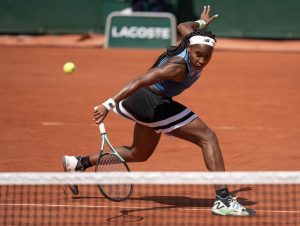It is a crying shame that just as women’s tennis is getting really interesting, it is effectively about to grind to a halt. The coronavirus-caused cancellation of the Asian swing, which represented the bulk of the WTA Tour’s autumn events, means that the French Open is not only the last Major event of the year for the women but the last significant tournament of any description. Fortunately, the clash between Sofia Kenin and Iga Swiatek has all the makings of a classic final.
And, perhaps more importantly, it might just be a sign of what is to come in the post-Serena Williams era of women’s tennis. By the time we reach the next Grand Slam, the 2021 Australian Open, four years will have passed since the great American last lifted one of tennis’ most prestigious trophies. Her last triumph took her to 23 Majors, just one short of the controversial Margaret Court’s all-time record and, at the time, it seemed inevitable that she would sail effortlessly past the Australian.
Now, however, that outcome is far from certain. Since returning from maternity leave, Williams has played in four Grand Slam finals, but she has failed to win a set in any of them. And that succession of losses in Major finals has now given way to something that will be even more concerning for fans of Williams: limp defeats long before the final and, as in Paris last week, withdrawals through injury.
Of course, this is not to say that Williams will never win another Major. In a sport as unpredictable as women’s tennis, it would be the height of folly to write off such a champion. But whether Williams wins another Grand Slam or not isn’t really the point. In the last decade, at least before her pregnancy, when Williams was focused solely on tennis, arguably for the first time in her career, she was a cut above every other player on the tour. Her defeats were truly seismic events.
But over the past few seasons, she has been relegated to the chasing pack. Indeed, as Mats Wilander so succinctly put it in New York last month, after Williams lost to Victoria Azarenka in the US Open semifinals, whilst the American is still a very good player, she is no longer a great one.
In the years after Williams’ last Major triumph, as it became increasingly apparent that she was experiencing more than a temporary blip, the players who had long laboured, with little reward, in her long shadow began to come to the fore. Caroline Wozniacki finally reached the summit by winning the Australian Open in 2018, a tournament Williams missed. Garbine Muguruza, who it is worth remembering beat Williams in her pomp at the 2016 French Open, was triumphant at Wimbledon.
Simona Halep, another player who had fallen agonisingly short at the Majors more than once, added her name to the roll of honour in Paris, beating Sloane Stephens, who had done the same at the US Open nine months earlier, in the final. Indeed, the WTA Tour turned into something of a free-for-all, with players seizing the chance to win the big titles that had for so long been denied to them by Williams’ unbreakable hold on the women’s game.
But it appears now that we might be witnessing a generational shift, with a number of younger – in some cases much younger – women emerging as Major champions. It began with Naomi Osaka’s run to the US Open title in 2018, with the Japanese hammering Williams in the final, aided in part by Williams’ implosion after an argument with the chair umpire. When she backed that up by winning the Australian Open in 2019 it appeared that the WTA might be trading one dominant force for another.
However, a combination of injuries and coaching changes, as well as a lack of affinity for clay and grass court tennis, ensured that did not come to pass. Indeed, 18 months elapsed between Osaka’s second and third Grand Slam wins, which, unsurprisingly, also came on a hard court in New York. That, of course, is not to unduly disparage the Japanese’s achievements. There are few players who have won three Major titles before their 22nd birthday.
So, rather than one single player replacing Williams at the top of the women’s game, there have been several. Bianca Andreescu matched Osaka’s achievement by beating Williams in the US Open final in 2019, although a catalogue of injuries have thus far prevented her from adding to her trophy cabinet. Ash Barty, the reigning French Open champion for another day at least, has elected not to play since the season resumed. And that has, for now, left the door ajar for another player to establish themselves as the future of the women’s game.
Two of the most promising candidates are none other than Kenin and Swiatek. The American Kenin is already a Major champion, having stunned the tennis world by winning the Australian Open in February, beating Muguruza in a thrilling final. Unfortunately, less than a month later the tennis season was suspended due to the global coronavirus pandemic which we are, regrettably, all now so familiar with, and Kenin’s sterling progress was brought to a halt.
At least until now. In Paris, despite having arrived in far from sparkling form, she has been playing with almost metronomic consistency en route to the final. As the British Billie Jean King Cup captain, Anne Keothavong, pointed out before her semifinal victory over the apparently resurgent Petra Kvitova, although Kenin’s highs might not be quite so lofty as Kvitova’s, nor are her lows nearly so low. Keothavong was more than vindicated as Kenin, unspectacularly but impressively, defeated Kvitova in straight sets.
In contrast, Swiatek has been electric in Paris, most of all in her utter demolition of top seed and pre-tournament favourite Halep. Swiatek, who lost 0-6 1-6 to Halep at the French Open last year, was in no mood to succumb so meekly again, instead producing one of the all-time great breakthrough performances. In fact, Swiatek was so good that Halep, a former-French Open and Wimbledon champion who had won her last 17 matches, looked entirely helpless.
Perhaps as impressively, Swiatek maintained that level, or at least something close to it, in her next two matches. That saw the young Pole dispatch the qualifiers Martina Trevisan and Nadia Podoroska, in the quarterfinals and semifinals respectively, losing only a handful of games when the pressure of being favourite might well have weighed other players down, to disastrous effect.
In tomorrow’s final, there is no clear favourite, although the fact that Kenin has already won a Major gives her a significant edge in terms of experience. Countering that advantage is the growing suspicion that Swiatek’s highest level, if she can reach it, might just be better than Kenin’s, for all the American’s extremely impressive efficiency. But whatever happens, whether it is Kenin or Swiatek who emerges victorious ,there is every chance that it will be not only a final for the ages, but also the beginning of the true post-Serena era in women’s tennis.
Main photo:
Embed from Getty Images






